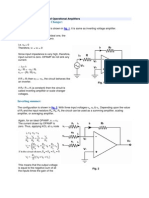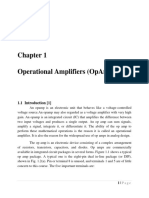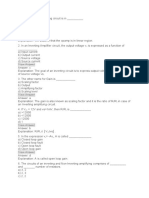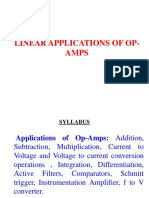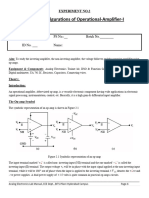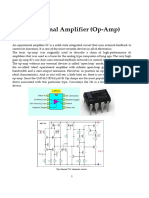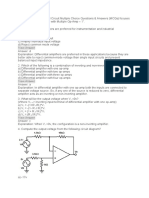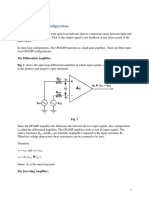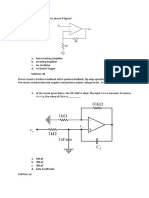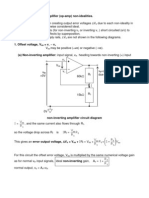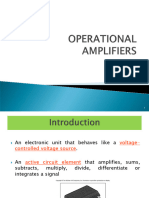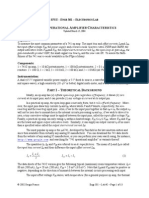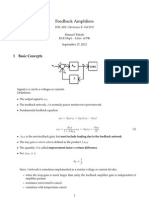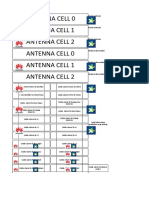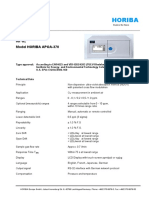0 ratings0% found this document useful (0 votes)
40 viewsVoltage Shunt Feedback
Voltage Shunt Feedback
Uploaded by
Sayan Kumar KhanThis document discusses voltage shunt feedback amplifiers using operational amplifiers. It describes how negative feedback works by reducing the output signal in response to increases in the feedback signal. The input resistance and output resistance with feedback are analyzed using Miller's theorem and Thevenin's equivalent circuit respectively. Examples are provided to calculate closed loop gain, input voltage, and output voltage for inverting and non-inverting amplifiers using feedback resistor values.
Copyright:
© All Rights Reserved
Available Formats
Download as PDF, TXT or read online from Scribd
Voltage Shunt Feedback
Voltage Shunt Feedback
Uploaded by
Sayan Kumar Khan0 ratings0% found this document useful (0 votes)
40 views6 pagesThis document discusses voltage shunt feedback amplifiers using operational amplifiers. It describes how negative feedback works by reducing the output signal in response to increases in the feedback signal. The input resistance and output resistance with feedback are analyzed using Miller's theorem and Thevenin's equivalent circuit respectively. Examples are provided to calculate closed loop gain, input voltage, and output voltage for inverting and non-inverting amplifiers using feedback resistor values.
Original Description:
2968
Original Title
2968
Copyright
© © All Rights Reserved
Available Formats
PDF, TXT or read online from Scribd
Share this document
Did you find this document useful?
Is this content inappropriate?
This document discusses voltage shunt feedback amplifiers using operational amplifiers. It describes how negative feedback works by reducing the output signal in response to increases in the feedback signal. The input resistance and output resistance with feedback are analyzed using Miller's theorem and Thevenin's equivalent circuit respectively. Examples are provided to calculate closed loop gain, input voltage, and output voltage for inverting and non-inverting amplifiers using feedback resistor values.
Copyright:
© All Rights Reserved
Available Formats
Download as PDF, TXT or read online from Scribd
Download as pdf or txt
0 ratings0% found this document useful (0 votes)
40 views6 pagesVoltage Shunt Feedback
Voltage Shunt Feedback
Uploaded by
Sayan Kumar KhanThis document discusses voltage shunt feedback amplifiers using operational amplifiers. It describes how negative feedback works by reducing the output signal in response to increases in the feedback signal. The input resistance and output resistance with feedback are analyzed using Miller's theorem and Thevenin's equivalent circuit respectively. Examples are provided to calculate closed loop gain, input voltage, and output voltage for inverting and non-inverting amplifiers using feedback resistor values.
Copyright:
© All Rights Reserved
Available Formats
Download as PDF, TXT or read online from Scribd
Download as pdf or txt
You are on page 1of 6
Voltage shunt Feedback:
Fig. 1, shows the voltage shunt feedback amplifier using OPAMP.
Fig. 1
The input voltage drives the inverting terminal, and the amplified as well as inverted output
signal is also applied to the inverting input via the feedback resistor R
f
. This arrangement forms a
negative feedback because any increase in the output signal results in a feedback signal into the
inverting input signal causing a decrease in the output signal. The non-inverting terminal is
grounded. Resistor R
1
is connected in series with the source.
The closed loop voltage gain can be obtained by, writing Kirchoff's current equation at the input
node V
2
.
mywbut.com
1
The negative sign in equation indicates that the input and output signals are out of phase by 180.
Therefore it is called inverting amplifier. The gain can be selected by selecting R
f
and R
1
(even <
1).
Inverting Input at Virtual Ground:
In the fig. 1, shown earlier, the noninverting terminal is grounded and the- input signal is applied
to the inverting terminal via resistor R
1
. The difference input voltage v
d
is ideally zero, (v
d
=v
O
/
A) is the voltage at the inverting terminals (v
2
) is approximately equal to that of the noninverting
terminal (v
1
). In other words, the inverting terminal voltage (v
1
) is approximately at ground
potential. Therefore, it is said to be at virtual ground.
mywbut.com
2
Input Resistance with Feedback:
To find the input resistance Miller
equivalent of the feedback resistor
R
f
, is obtained, i.e. R
f
is splitted
into its two Miller components as
shown in fig. 2. Therefore, input
resistance with feedback R
if
is then
Fig. 2
Output Resistance with Feedback:
The output resistance with
feedback R
of
is the resistance
measured at the output terminal of
the feedback amplifier. The output
resistance can be obtained using
Thevenin's equivalent
circuit,shown in fig. 3.
i
O
=i
a
+i
b
Since R
O
is very small as compared
to R
f
+(R
1
|| R
2
)
Therefore,i.e. i
O
=i
a
v
O
=R
O
i
O
+A v
d
.
v
d
=v
i
v
2
=0 - B v
O
Fig. 3
mywbut.com
3
Similarly, the bandwidth increases
by (1+AB) and total output offset
voltage reduces by (1+AB).
Example - 1
(a).An inverting amplifier is implemented with R
1
=1K and R
f
=100 K. Find the percentge
change in the closed loop gain A is the open loop gain a changes from 2 x 10
5
V / V to 5 x
10
4
V/V.
(b) Repeat, but for a non-inverting amplifier with R
1
=1K at R
f
=99 K.
Solution: (a). Inverting amplifier
Here R
f
=100 K
R
1
=1K
When,
(b) Non-inverting amplifier
mywbut.com
4
Here R
f
=99 K
R
1
=1K
Example - 2
An inverting amplifier shown in fig. 4 with R
1
= 10 and R
2
= 1M is driven by a source v
1
=
0.1 V. Find the closed loop gain A, the percentage division of A from the ideal value - R
2
/ R
1
,
and the inverting input voltage V
N
for the cases A =100 V/V, 10
5
and 10
5
V/V.
Solution:
we have
when A =10
3
,
Fig. 4
mywbut.com
5
Example - 3
Find V
N
, V
1
and V
O
for the circuit shown in fig. 5.
Solution:
Applying KCL at N
or 2V
N
+V
N
=V
O
.
Now V
O
- V
i
=6 as point A and N are virtually
shorted.
V
O
- V
N
=6 V
Therefore, V
O
=V
N
+6 V
Therefore, V
N
=V
i
=3 V.
Fig. 5
mywbut.com
6
You might also like
- JAVA Hand Written Notes Download Part 1Document19 pagesJAVA Hand Written Notes Download Part 1Sayan Kumar Khan80% (44)
- Devices Experiment 1 - Inverting and Non-InvertingDocument16 pagesDevices Experiment 1 - Inverting and Non-InvertingYanique Gibbs100% (1)
- OpAmp ExampleDocument16 pagesOpAmp ExampleYi Ming Tan100% (1)
- Final Op Amp Lab ReportDocument7 pagesFinal Op Amp Lab Reportmehrin12367% (3)
- Stationary Charger PDFDocument2 pagesStationary Charger PDFFrancisco MatosNo ratings yet
- Electronics Communication Engineering Analog Electronics Voltage Shunt Feedback NotesDocument6 pagesElectronics Communication Engineering Analog Electronics Voltage Shunt Feedback Notesjeswitha mekalaNo ratings yet
- Lecture - 11:: Applications of Operational AmplifiersDocument47 pagesLecture - 11:: Applications of Operational AmplifiersMani Kandan KNo ratings yet
- Analog Inverter and Scale Changer:: Applications of Operational AmplifiersDocument58 pagesAnalog Inverter and Scale Changer:: Applications of Operational Amplifiersgnpr_10106080No ratings yet
- دوائر الكترونية كورس اولDocument35 pagesدوائر الكترونية كورس اولyasa1990No ratings yet
- Shigley S Mechanical Engineering Design 9th Edition Solutions ManualDocument29 pagesShigley S Mechanical Engineering Design 9th Edition Solutions ManualZaim AkmalNo ratings yet
- Tutorial CH 3Document33 pagesTutorial CH 3gebretsadkan abrhaNo ratings yet
- AnalogDocument33 pagesAnalogAmit UpadhyayNo ratings yet
- OpAmp Q PDFDocument31 pagesOpAmp Q PDFShahbaz AhmedNo ratings yet
- Unit 2 Non-Inverting and Inverting AmplifierDocument6 pagesUnit 2 Non-Inverting and Inverting AmplifierUmaNo ratings yet
- Linear Applications of Op-AmpsDocument94 pagesLinear Applications of Op-AmpsManar HosnyNo ratings yet
- Op-Amp Practical Applications: Design, Simulation and Implementation - 2019 Week 0 Assignment SolutionDocument12 pagesOp-Amp Practical Applications: Design, Simulation and Implementation - 2019 Week 0 Assignment SolutionSalil ChourasiaNo ratings yet
- Basic AppsDocument10 pagesBasic AppsHendra LeosuNo ratings yet
- Operational AmplifiersDocument12 pagesOperational AmplifiersShachi P GowdaNo ratings yet
- DA1ECE3013Document11 pagesDA1ECE3013Anonymous HA6894aNo ratings yet
- Feedback AmplifierDocument52 pagesFeedback AmplifierBharavi K SNo ratings yet
- LIC Mod2.docDocument13 pagesLIC Mod2.docjith2808No ratings yet
- Basic AppsDocument10 pagesBasic AppsajayganeshNo ratings yet
- Experiment 2 - 2021AAPS3021HDocument9 pagesExperiment 2 - 2021AAPS3021Hasheshverma2003No ratings yet
- Analysis of Shunt OneDocument11 pagesAnalysis of Shunt OneMaryam SaeedNo ratings yet
- 6-Integrator: A Resistor RFDocument4 pages6-Integrator: A Resistor RFyasa1990No ratings yet
- Lecture 8Document8 pagesLecture 8Mister TomNo ratings yet
- Homework#5 For Microelectronics (I)Document12 pagesHomework#5 For Microelectronics (I)Bruno IensenNo ratings yet
- ACLab 1Document7 pagesACLab 1PRERIT RUDRAKARNo ratings yet
- Rohini 41414986331Document12 pagesRohini 41414986331Sridarshini VikkramNo ratings yet
- Op Amp TutorialDocument12 pagesOp Amp Tutorialavneesh_singhNo ratings yet
- Analog-Circuit-EC-405-UNIT-IV (1)Document49 pagesAnalog-Circuit-EC-405-UNIT-IV (1)thepofessionalguyNo ratings yet
- Op AmpDocument9 pagesOp AmpMahmoud Eldabah100% (1)
- Applications of OP AMPDocument40 pagesApplications of OP AMPVarun VarmaNo ratings yet
- Ac Lab Manual (ENP 255) : Name: - Vaishnavi Dubey Roll No: - 18 Section: - B Department: - Electronics Experiment No: - 1Document14 pagesAc Lab Manual (ENP 255) : Name: - Vaishnavi Dubey Roll No: - 18 Section: - B Department: - Electronics Experiment No: - 1Manish YadavNo ratings yet
- Unit 2 Differential AmplifierDocument3 pagesUnit 2 Differential AmplifierUmaNo ratings yet
- Open Loop OPAMP Configuration PDFDocument12 pagesOpen Loop OPAMP Configuration PDFSayan ChowdhuryNo ratings yet
- Analysis, Design and Characteristics of Op-Amp & Second Order FilterDocument9 pagesAnalysis, Design and Characteristics of Op-Amp & Second Order FilterManraj GujralNo ratings yet
- Week4 Assignment PDFDocument11 pagesWeek4 Assignment PDFSalil ChourasiaNo ratings yet
- Chapter 5 Operational Amplifiers: Sung-Liang Chen VE215 Fall 2022Document68 pagesChapter 5 Operational Amplifiers: Sung-Liang Chen VE215 Fall 2022yi yang GuNo ratings yet
- Effects of Operational Amplifier (Op-Amp) Non-Idealities.: R V I R R V VDocument4 pagesEffects of Operational Amplifier (Op-Amp) Non-Idealities.: R V I R R V VMohammad Nasfikur Rahman KhanNo ratings yet
- Lab 5 (1903069)Document5 pagesLab 5 (1903069)Tahsin Zaman TalhaNo ratings yet
- ELE302 NotesDocument70 pagesELE302 NotesAnmol PanchalNo ratings yet
- MCQ 3Document12 pagesMCQ 3Mister TomNo ratings yet
- Chapter 12 (Electronic Devices and Circuits-II) (1) FinalDocument50 pagesChapter 12 (Electronic Devices and Circuits-II) (1) FinalAhmed HussainNo ratings yet
- Op-AmpDocument43 pagesOp-AmpHriday TejwaniNo ratings yet
- EE 200 - Electronic Circuits Implementation Lab #4Document8 pagesEE 200 - Electronic Circuits Implementation Lab #4Poyraz EmelNo ratings yet
- Unit 1 AmplifiersDocument46 pagesUnit 1 Amplifiersvimalaspl7831No ratings yet
- OP TypesDocument17 pagesOP TypesAhmad DboukNo ratings yet
- Exp 7Document3 pagesExp 7MohammedZahidNo ratings yet
- Tutorial 2 AnsDocument9 pagesTutorial 2 AnsKemproof100% (3)
- Tutorial 1Document7 pagesTutorial 1Rahul RajNo ratings yet
- Amplifier Circuit Lab WorkDocument24 pagesAmplifier Circuit Lab WorkSandeep PatwaNo ratings yet
- L #2: O A C: Sfsu - E 301 - E L AB Perational Mplifier HaracteristicsDocument13 pagesL #2: O A C: Sfsu - E 301 - E L AB Perational Mplifier HaracteristicsRudra MishraNo ratings yet
- Feedback Feedback Topologies PDFDocument12 pagesFeedback Feedback Topologies PDFOrlando Jose Heredia0% (1)
- OpAmp Golden RulesDocument8 pagesOpAmp Golden RulesChai Min HiungNo ratings yet
- DC CharteristDocument7 pagesDC CharteristDr.S.Jaganathan HoD EEENo ratings yet
- The RC Phase Shift OscillatorDocument12 pagesThe RC Phase Shift OscillatorvikashrahiNo ratings yet
- Easy(er) Electrical Principles for General Class Ham License (2015-2019)From EverandEasy(er) Electrical Principles for General Class Ham License (2015-2019)Rating: 5 out of 5 stars5/5 (1)
- Easy(er) Electrical Principles for Extra Class Ham License (2012-2016)From EverandEasy(er) Electrical Principles for Extra Class Ham License (2012-2016)No ratings yet
- Exercises in Electronics: Operational Amplifier CircuitsFrom EverandExercises in Electronics: Operational Amplifier CircuitsRating: 3 out of 5 stars3/5 (1)
- Easy(er) Electrical Principles for General Class Ham License (2019-2023)From EverandEasy(er) Electrical Principles for General Class Ham License (2019-2023)No ratings yet
- Ju Ug Placement Records 2019-20Document2 pagesJu Ug Placement Records 2019-20Sayan Kumar KhanNo ratings yet
- DurgaSoft SCJP Notes Part 1 - JavabynataraJ PDFDocument255 pagesDurgaSoft SCJP Notes Part 1 - JavabynataraJ PDFSiva Sai Charan KondapiNo ratings yet
- Java Applet BasicsDocument10 pagesJava Applet BasicsrednriNo ratings yet
- Compiler Hand Written Notes Made EasyDocument127 pagesCompiler Hand Written Notes Made EasyArpkeet IJNo ratings yet
- Novak DjokovicDocument12 pagesNovak DjokovicSayan Kumar Khan100% (1)
- Micro NotesDocument24 pagesMicro NotesSayan Kumar KhanNo ratings yet
- MicrocontrollerDocument414 pagesMicrocontrollerSayan Kumar KhanNo ratings yet
- Paper 16Document28 pagesPaper 16Sayan Kumar KhanNo ratings yet
- Micro Notes 2-1Document11 pagesMicro Notes 2-1Sayan Kumar KhanNo ratings yet
- PaperDocument14 pagesPaperSayan Kumar KhanNo ratings yet
- Paper 13Document22 pagesPaper 13Sayan Kumar KhanNo ratings yet
- Paper 4Document16 pagesPaper 4Sayan Kumar KhanNo ratings yet
- Fiitjee: JEE (Advanced), 2015Document24 pagesFiitjee: JEE (Advanced), 2015Sayan Kumar KhanNo ratings yet
- Paper 6Document20 pagesPaper 6Sayan Kumar KhanNo ratings yet
- Memory-Interfacing: LessonDocument8 pagesMemory-Interfacing: LessonSayan Kumar KhanNo ratings yet
- EEE122A Boolean Algebra and Logic GatesDocument38 pagesEEE122A Boolean Algebra and Logic GatesSayan Kumar KhanNo ratings yet
- Design of Embedded ProcessorsDocument80 pagesDesign of Embedded ProcessorsSayan Kumar KhanNo ratings yet
- Analog Interfacing: LessonDocument13 pagesAnalog Interfacing: LessonSayan Kumar KhanNo ratings yet
- Damerau Levenshtein Algorithm by R - GDocument5 pagesDamerau Levenshtein Algorithm by R - GSambreenNo ratings yet
- TAP Magazine - Issue #101Document10 pagesTAP Magazine - Issue #101GBPPRNo ratings yet
- 40A Breaker Control SwitchesDocument4 pages40A Breaker Control SwitchesAnand MuraliNo ratings yet
- (Solidfiles /X86-Unlocked) : DownloadDocument8 pages(Solidfiles /X86-Unlocked) : DownloadCrackaboutNo ratings yet
- UPDATED AH Furutec AH Aluminium Product Catalogue-22022021 - 1657770295Document33 pagesUPDATED AH Furutec AH Aluminium Product Catalogue-22022021 - 1657770295mel perezNo ratings yet
- LTE CELL Planning: Security LevelDocument31 pagesLTE CELL Planning: Security Levelwiwitraharjo100% (1)
- 以婚紗產業為例 探討文化創意產業產業化關鍵成功因素Document124 pages以婚紗產業為例 探討文化創意產業產業化關鍵成功因素ninewind2025No ratings yet
- Software Development Life CycleDocument28 pagesSoftware Development Life CycleAhmed BaniMustafaNo ratings yet
- QP CON Q0102 Assistant Mason v2.0Document43 pagesQP CON Q0102 Assistant Mason v2.0neha sehgalNo ratings yet
- Standard Label GSM-DCS-3G-LTE-U900 XL Project - Final V 1.1Document31 pagesStandard Label GSM-DCS-3G-LTE-U900 XL Project - Final V 1.1godeg009No ratings yet
- Arduino Based Automatic Plant Irrigation System With MessageDocument12 pagesArduino Based Automatic Plant Irrigation System With Messagesiri.pogula0% (1)
- WRT-416 RouterDocument47 pagesWRT-416 Routermadmax_mfpNo ratings yet
- Kenwood TRC-80 - User Manual PDFDocument33 pagesKenwood TRC-80 - User Manual PDFRobert/YG2AKR73% (11)
- Unit 16 Cold Hard Cash Sept PDFDocument28 pagesUnit 16 Cold Hard Cash Sept PDFYanz MuhamadNo ratings yet
- TAGIC-Claim-form FilledDocument2 pagesTAGIC-Claim-form FilledRaghavan KathamuthuNo ratings yet
- N67-TE2A 193-215kW T2Document2 pagesN67-TE2A 193-215kW T2Vũ Hằng PhươngNo ratings yet
- 蔡仁松教授資料結構 - L1AB - Course IntroductionDocument8 pages蔡仁松教授資料結構 - L1AB - Course IntroductionBrian ChengNo ratings yet
- PXM4/6/8K Meter Advanced Color Touchscreen Display Quick Start GuideDocument6 pagesPXM4/6/8K Meter Advanced Color Touchscreen Display Quick Start Guides.ganapathy RamanNo ratings yet
- ShortingDocument27 pagesShortingRatnakarVarunNo ratings yet
- HGTG7N60A4D, HGTP7N60A4D, HGT1S7N60A4DS: 600V, SMPS Series N-Channel IGBT With Anti-Parallel Hyperfast Diode FeaturesDocument9 pagesHGTG7N60A4D, HGTP7N60A4D, HGT1S7N60A4DS: 600V, SMPS Series N-Channel IGBT With Anti-Parallel Hyperfast Diode FeaturesJarden VegaNo ratings yet
- BS en 10120-2008Document14 pagesBS en 10120-2008gusla7No ratings yet
- CBC Elect Install and Maint NC IIIDocument99 pagesCBC Elect Install and Maint NC IIIRoderick Rosanes100% (1)
- 24 - Fispq Silicone Grey 999Document1 page24 - Fispq Silicone Grey 999lucasNo ratings yet
- CATIA V5 As Multitasking Macine Tools Programming EnvironmentDocument4 pagesCATIA V5 As Multitasking Macine Tools Programming EnvironmentSuresh RajagopalNo ratings yet
- PJT-PDP-TLM-733 Project Document & Drawing NumberingDocument19 pagesPJT-PDP-TLM-733 Project Document & Drawing NumberingseehariNo ratings yet
- T474 TYM Tractor Brochure Lite Version - 28032022Document9 pagesT474 TYM Tractor Brochure Lite Version - 28032022Nathan ManginNo ratings yet
- Radial Leaded 3PTC Resettable Fuse: FRX 050-60F: 1. SummaryDocument7 pagesRadial Leaded 3PTC Resettable Fuse: FRX 050-60F: 1. SummaryАнатолий ДонецкNo ratings yet
- Horiba: Continuous Monitor For O Model HORIBA APOA-370Document2 pagesHoriba: Continuous Monitor For O Model HORIBA APOA-370ikarimzaiNo ratings yet
- 04const FlatDocument54 pages04const FlatBirhane Bekele KebedeNo ratings yet







